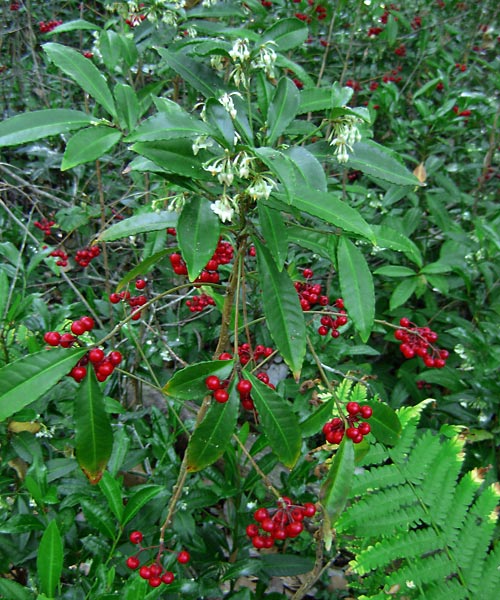EDRR Invasive Species
Coral Ardisia (Ardisia crenata)
Define Invasive Species: must have ALL of the following –
- Is non-native to the area, in our case northwest Florida
- Introduced by humans, whether intentional or accidental
- Causing either an environmental or economic problem, possibly both
Define EDRR Species: Early Detection Rapid Response. These are species that are either –
- Not currently in the area, in our case the Six Rivers CISMA, but a potential threat
- In the area but in small numbers and could be eradicated
Native Range:
Japan and northern India
Introduction:
Was introduced intentionally as an ornamental plant in the early 1900s. In 1982 it escaped cultivation and spread through wooded areas of Florida and parts of the Gulf coast.
EDDMapS currently list 2,064 records of coral ardisia. Most are in Florida but there are records in the Gulf states, Georgia, and South Carolina. Records within Florida cover the state, but has not been reported from all counties.
Within Six Rivers CISMA there are 11 records including Baldwin, Santa Rosa, Okaloosa, and Holmes Counties.
Description:
Coral ardisia grows in clumps, many times multi-stemmed in wooded areas. It has long (8”) glossy leaves that are dark green in color and has scalloped margins. The flowers are whiteish pink and droop below the leaf cover. The fruit are bright red berries that also droop from the plant and are present much of the year.
Issues and Impacts:
Like many invasive plants, coral ardisia spreads aggressively replacing native plants where they can. Though no published literature, it is believed to be toxic to livestock, pets, and humans.
It is a Category I invasive plant and a Florida Noxious Weed. It is listed as prohibited by the UF IFAS Assessment.
Management:
Step 1 is to avoid planting coral ardisia in your landscape. It is listed as a Florida noxious weed, and thus should not be sold, but transplanting is prohibited. If it can be easily removed by hand from your landscape, do so before it goes to seed. Be careful not to spread seeds.
Disking and/or burning can be effective however (a) most areas where coral ardisia grows prohibits disking and/or burning and (b) unless you removed all of the deep rhizomes it may return, so annual surveys are still needed.
Chemical treatments typically use the active ingredient triclopyr. This herbicide can be applied directly to the leaves or by applying to the bark when the plant is relatively dry. For large areas needing treatment the formulas may change. Different mixtures can be found in the references below. Annual retreatment may be required. Contact your local county extension office if you have questions.
References
Ardisia crenata. 2022. University of Florida Center for Aquatic and Invasive Plants. https://plants.ifas.ufl.edu/plant-directory/ardisia-crenata/.
Ardisia crenata. 2019. University of Florida IFAS Assessment of Non-Native Plants. https://assessment.ifas.ufl.edu/assessments/ardisia-crenata/.
Sellers, B.A., Enloe, S.F., Minogue, P., Walter, J. 2021. Identification and Control of Coral Ardisia (Ardisia crenata): Potentially Poisonous Plant. University of Florida IFAS Electronic Digital Information System (EDIS) publication #SS AGR-276. https://edis.ifas.ufl.edu/publication/AG281.
Early Detection and Distribution Mapping System (EDDMapS)
Six Rivers CISMA
https://www.floridainvasives.org/sixrivers/
- Tips for Bear Encounters this Fall - November 10, 2025
- Pensacola Bay Invasive Species Summer Survey 2025 - November 3, 2025
- Our Environment: Part 24 – Our Changing Climate - November 3, 2025

